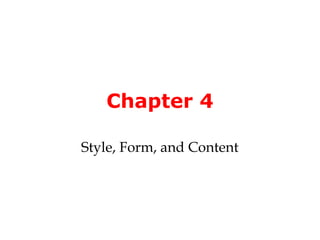
Chapter4
- 1. Chapter 4 Style, Form, and Content
- 2. The duty of an artist is to strain against the bonds of the existing style. –Philip Johnson
- 3. • There are several characteristic methods of expression that have developed that are referred to as style. • The content of a work includes not only its form but also its subject matter and its underlying meanings or themes. • Awareness of style, form, and content helps the viewer understand and appreciate the visual arts more fully.
- 4. STYLE • Style - The handling of distinctive elements and particular media throughout the various artistic periods associated with the work of an individual artist, a school or movement, of a specific culture or time period.
- 5. Art, Culture, and Context • Variations in style are sometimes linked to: – use of different media – diverse cultural contexts – characteristic approach of the artist to the subject “Context has a profound influence on style.”
- 6. Art, Culture, and Context One of the best ways to illustrate stylistic differences is to examine a group of artworks with a common theme, such as the “couple”. The works of most artists are a product of their culture and time. There are LOTS of styles in art, and they change often, yet there are some standards.
- 7. Fig. 4.9, p.97 GRANT WOOD. American Gothic (1930). Oil on beaverboard. 29-7⁄8” x 24-7⁄8”.
- 8. Fig. 4.3, p.93 HENRI DE TOULOUSE-LAUTREC. The Two Girlfriends (1894). Oil on cardboard. 48 cm x 34.5 cm.
- 9. Fig. 4.2, p.92 ROY LICHTENSTEIN. Forget It, Forget Me! (1962). Magna and oil on canvas. 79-7⁄8” x 68”.
- 10. Fig. 4.4, p.93 ROBERT MAPPLETHORPE. Ken Moody and Robert Sherman (1984). Photograph.
- 20. Realistic Art realism - is the portrayal of people and things as they are seen by the eye or as they are thought to be without idealization, without distortion. Realism - (with a capital R) also defines a specific school of art that flowered during the mid-nineteenth century in France.
- 21. Photography We think of most photography as realistic: • The technique of shooting, capturing, and documenting, suggests candid truth, and reality.
- 27. Realistic versus Representational Art • Representational art presents natural objects in a recognizable manner, although not a realistic form. • Representational art or figurative art - is defined as art that portrays, however altered or distorted, things perceived in the visible world.
- 32. Expressionistic Art • In expressionistic art, form and color are freely distorted by the artist in order to achieve a heightened emotional impact • Expressionistic - also a modern art movement
- 36. Abstract Art • Abstract - Art that departs significantly from the actual appearance of things. • Nonobjective - Art that makes no reference to nature or reality. • Cubism - Transcribed natural forms into largely angular geometric equivalents • Psychic Automation - When an artist attempts to clear their mind of purpose and concerns so that inner conflicts and ideas find expression through their works.
- 54. COMPARE + CONTRAST • The style of a work of art refers to the characteristic ways in which artist’s express themselves and the times in which they live. • Conceptual art - The ideas being expressed by the artist are more important than their physical expression.
- 58. Copy nature and you infringe on the work of our lord. Interpret nature and you are an artist. -- JACQUE LIPCHITZ • Artist often title abstract works to provoke thought. • They may title a work “untitled” to avoid associations created by the title. • They may deliberately title a nonobjective work based on some association triggered by the work. • One of the issues that viewers have with non- objective work is that they want to it to make sense. Nonobjective work is just that, nonobjective.
- 59. FORM • Form incorporates elements, design principles, and composition in a work of art. This might include: – Color – Texture – Shape – The illusion of 3D – Balance – Rhythm – Unity of design • Formalistic criticism involves the elements and design but not the historical or biographical elements of a work of art.
- 60. Content Content - everything included in a work of art • The content of a work of art not only refers to lines and forms but also its underlining meanings or themes.
- 61. The Levels of Content in a Work of Art Three levels of content: • Subject Matter • Elements and composition • Underlying or symbolic meanings or themes
- 62. Compare + Contrast • An awareness of the historical circumstances under which a work of art was created, understanding what is new about its style and composition help the viewer appreciate its significance. • Understanding the relationship between these next two pieces, makes each more meaningful to the viewer.
- 63. Fig. 4.12, p.99 JACQUES-LOUIS DAVID. Death of Marat (1793). Oil on canvas. 63-3⁄4” x 49-1⁄8”. Fig. 4.13, p.99 SANDOW BIRK. Death of Manuel (1992). Oil on canvas. 33” x 25”.
- 64. Iconography Iconography - The study of the themes and symbols in the visual arts. • In fine art, winter is a common symbol of death and aloneness. • Fall is a common symbol of harvest and decline. • Awareness of symbolism can enrich the viewing experience.